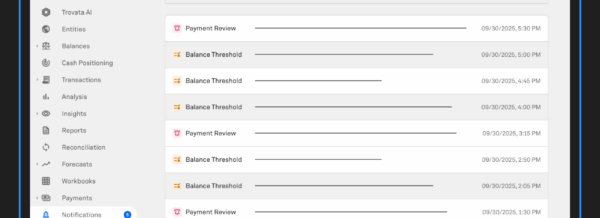Treasurers have a lot on their plate. The low interest rate environment of the 2010’s arguably simplified corporate strategy across many executive functions, including treasury. With money so cheap and growth relatively strong, the focus was simply on growth (don’t get the pitchforks out, simple doesn’t mean easy!)
From a cash flow standpoint, this provided Treasurers with a greater margin for error. That’s all changed. The past 5 years have put Treasurers and other senior executives in a position where they need to play a perfect game to stay competitive. This has led to some common cash management mistakes that hinder cash flow.
Not only has the funding environment changed dramatically, the overall economic landscape has turned 180 degrees, there are a large number of challenges in managing a modern workforce, and technology is throwing up new competition and opportunities.
For Treasurers, that makes managing cash flow both more important, and more difficult. Where technology and process limitations or inefficiencies could be worked around in previous years, they now represent key issues that modern Treasurers need to find solutions for.
Let’s take a look at some common cash management mistakes that are still being made by Treasurers, and how using the right treasury technology can help avoid them.

The 5 Biggest Cash Management Mistakes Treasurers Are Making
This is by no means an exhaustive list. Every business and sector faces their own unique challenges, but the below contains some of the most common, universal mistakes that can make the role of a Treasurer more challenging than it needs to be.
1. Lacking Full Visibility into Global Cash
In the past, this wouldn’t have fallen under the category of a mistake, but would instead have been described as a system limitation. But with modern treasury technology and the use of APIs (more on that later), there’s no need for Treasurers to struggle with this anymore.
Many companies operate a complex mix of banking arrangements, spread across multiple financial organizations and banking portals. It’s also become increasingly important to integrate with non-bank payment platforms such as Stripe and WePay.
This is further complicated when operating across multiple entities and currencies.
Without visibility of the cash position and transaction history across all of this, treasurers are at a substantial disadvantage. A lack of cash visibility makes it difficult to make informed decisions and hampers the capacity to create accurate forecasts and scenario plans.
2. Using Manual Cash Management Processes
Going hand in hand with the lack of cash visibility is the mistake of running a treasury and finance function with a high number of manual processes. The need to manually download, normalize, and combine data from all banking and financial platforms takes a significant amount of time and human resources.
Not only that, but the process introduces substantial risk to the business with the potential for transcription or formula errors.
Because of the time it takes to gather and organize a large amount of banking data manually, treasurers are always working with out-of-date information. That’s a serious issue for cash flow management, where problems can arise quickly.
3. Relying on Fragmented Systems
The next mistake many treasurers are making is relying on a fragmented treasury tech stack. In many organizations, treasury management systems, ERP software, and various banking portals operate in silos, creating a disjointed flow of information.
This fragmentation means that systems don’t communicate with each other effectively, leading to multiple teams logging into separate bank portals and platforms just to build routine reports. The lack of integration hampers the treasurer’s ability to get a comprehensive, real-time view of the company’s cash position.
This fragmentation not only slows down operations but also increases operational costs. Each additional login and manual reconciliation process adds to the workload, consuming valuable time that could be spent on strategic activities.
Plus, the use of multiple banking portals can escalate bank fees, as different banks charge for access, transactions, and maintenance separately.
Recommended: For Treasury Technology That Actually Works – Prioritize Integration
4. Inefficient Capital Management
It may be a little unfair to call this a mistake, because there’s often no other choice without implementing the right treasury technology. But still, inefficient capital management, particularly failing to maximize the yield on dormant cash, is a common occurrence.
This issue is another symptom that comes from the lack of comprehensive cash visibility. When Treasurers don’t have a clear, real-time picture of their cash positions, they are forced to err on the side of caution. As a risk management strategy, this often means holding excess cash reserves (especially within subsidiaries) to ensure liquidity and protect against potential cash flow disruptions.
While this conservative approach mitigates immediate liquidity risks, it also results in significant opportunity costs. Excess cash that sits idle in low-yield accounts represents a missed opportunity to generate higher returns. Simply put, Treasurers who use their cash efficiently and maximize yield can use it as both a defensive buffer and a revenue contributor.
5. Insufficient Forecasting and Scenario Planning
The final mistake on our list is insufficient forecasting and scenario planning. Accurate forecasting and the ability plan for multiple scenarios are absolute musts for Treasurers who want to make informed strategic decisions. However, many treasurers still rely on outdated methods (à la spreadsheets) and static data, which makes forecasting slow, cumbersome, and prone to errors.
Without robust forecasting, treasurers can be forced into reactive (rather than strategic) decision-making. This can mean scrambling for liquidity solutions, often at a higher cost or less favorable terms.
Effective forecasting and scenario planning require integrating real-time data with advanced analytics. By leveraging modern treasury technologies, treasurers can access dynamic forecasting models that take into account various internal and external factors, updated automatically with real data.
How The Right Tech Helps Fix These Mistakes
All of these mistakes can be fixed with the right tools. Many of the inefficiencies or ‘band-aid’ solutions that Treasurers have made work over the years come down to working within the limitations of their tech stack or workflow.
Treasury tech has come a long way since spreadsheets and the early ERP systems, providing far more in terms of features and capabilities. Here’s some of the core tech features that can help eliminate the biggest treasury mistakes:
API Bank Connectivity
At the center of this modern approach are APIs, which are technology that allows software programs to talk directly to each other. It’s the same tech that allows the data from your 5k run to transfer from your Apple watch to Strava or one of the other thousands of fitness apps out there.
For treasury, it’s the tech that enables all of a company’s banking data to be viewed within a single platform. That’s why it’s no surprise that a recent survey found that 42% of treasury professionals are actively engaged in implementing APIs.
By connecting a company’s treasury management system and its banking partners, APIs provide real-time access to account balances, transaction details, and payment status across multiple banks and accounts. This direct, automated connection eliminates the need for manual data entry and the use of multiple banking logins, significantly improving efficiency and accuracy.

With APIs, treasurers can achieve complete cash visibility across all accounts, regions, and currencies. This real-time visibility gives Treasurers everything they need to make more informed decisions, optimize liquidity management, and reduce the risk of cash shortfalls.
In addition, APIs provide a foundation for accurate, timely cash flow forecasting by delivering up-to-date data that can be instantly incorporated into forecasting models.
The use of APIs also enhances security and compliance. Direct bank connectivity through APIs reduces the need for manual interventions and data handling, lowering the risk of errors and fraud. APIs can also support compliance with regulatory requirements by providing auditable trails of transactions and real-time reporting capabilities.
It’s not hyperbole to call APIs revolutionary tech for Treasurers.
Cloud-Native Tech
Cloud-native technology represents a significant advancement over legacy ‘cloud-based’ systems. Unlike traditional systems that were adapted for the cloud from on-premises infrastructure, cloud-native solutions are designed specifically to operate in the cloud environment. This difference might seem subtle, but the benefits aren’t.
Firstly, cloud-native tech provides limitless scalability and enhanced flexibility. It allows treasurers to easily scale bank data up or down based on business needs without the limitations of physical hardware. This ensures that treasury operations can adapt swiftly to your business’s growth as it adds more banks and accounts.
Secondly, the system architecture of cloud-native solutions ensures high availability and minimal downtime. This helps to optimize the use of idle cash through automated, scalable, and reliable technology solutions.
Automated Reporting and Forecasting
Automated reporting and forecasting capabilities directly address several of the mistakes we’ve outlined. With APIs connecting data sources directly to the forecasting tools, they can be automatically updated with real data. From there, machine learning algorithms help detect patterns and highlight trends that may warrant a closer look.

This process saves time, allowing treasury teams to focus on high value strategic work. And because it makes the forecasting process so much more efficient, Treasurers can assess a wider range of scenarios before making important decisions.
Comprehensive Tagging and Search Capabilities
Finally, tagging and advanced search helps address the inefficiencies caused by fragmented data and manual categorization. By utilizing tags to automate the categorization of transactions, treasurers can quickly organize and report on their financial data. This automation reduces the time and effort required to classify and reconcile potentially millions of line items, minimizing the risk of errors and oversight.

And when you need to get into the weeds, a flexible search language allows treasurers to easily locate specific transactions or sets of data within a vast dataset.

Level Up Your Treasury Function With Trovata
Trovata offers modern treasury teams all of these features and more. The cloud-native, API first solution provides a real-time, 100% accurate view of your entire financial position, in one place.
In addition to enhanced visibility and forecasting capabilities, treasury teams are also able to transact within the very same platform, with APIs providing not just read-only access but the ability to generate payments as well.
Trovata offers treasury and finance teams an all-in-one solution that improves efficiency, reduces risk and enables strategic decision-making.

If you’d like to see how Trovata can level up your treasury team, book a demo today.




